War toys like 'Call of Duty,' G.I. Joe shape our future military, but is it a good thing?
"G.I. Joe Attack! BOOM BOOM!"
That is the sound of American combat. The year: 1964. The place: The sandbox.
"When you get G,I. Joe and the authentic G.I. Joe equipment, you'll have the greatest realism, the greatest fun you ever had playing soldier!" booms the voice in the TV commercial, as kids deploy their Action Figures — never "dolls" — around their backyard battleground. Hasbro's original 1964 ad ends with this Zen koan: "Remember, only G.I. Joe is G.I. Joe!"
As a motto, it may not be quite up to "Semper Fidelis."
But Michael Boll, U.S. Marine, veteran of The Gulf War from August 1990 to June 1991, founder of the New Jersey Veteran's Network, has tried to live up to both.
Like many veterans — like many of us — he will be Always Faithful to G.I. Joe. Over the years, he's collected nearly 100 of them.
"I remember the first Kung Fu Grip G.I. Joe," he said. "I remember playing with it when my cousin came over to the house. He's a really big guy, 6 foot 2, 6 foot 3. He looked like G.I. Joe."
Memorial Day, May 29 — the day we honor our war dead — might seem like an odd time to look back at the legacy of war toys. What do G.I. Joes, tin soldiers, cap guns, little green plastic soldiers, and video games like "Call of Duty" have to do with the men and women who gave their lives for their country?
Maybe a lot. Which is why war toys have always been a fraught subject.
Soldiers of tomorrow
Are they builders of character, boosters of patriotism? Or are they propaganda? Childhood indoctrination, for a war-mongering culture?
Or are they just a normal outlet for the aggressions of a normal eight-year-old?
"Most kids want to feel heroic and empowered," said Chris Bryne, a toy industry consultant.
War play is military experience, of a kind. One of the few that vets and non-vets have in common. For some of us civilians, it is our only window into their world.
"When you're six years old and your life is eat your peas and go to school, being able to stand in your toy turret gun and mow down your enemies is fun," Byrne said.
Come again? Yes, this was a real toy — marketed in 1961 by Newark-based Remco Inc.
"There goes a B-52 jet bomber! America's newest defender! Wish you were part of her crew? Now you can experience this thrill with the REMCO 552 BALL TURRET GUN!!" Complete — the TV ad tells us — with radar scope, intercom and oxygen mask! And all for $13.98!
"That looks awesome," Boll said. "The coolest thing a kid could want."
An old idea
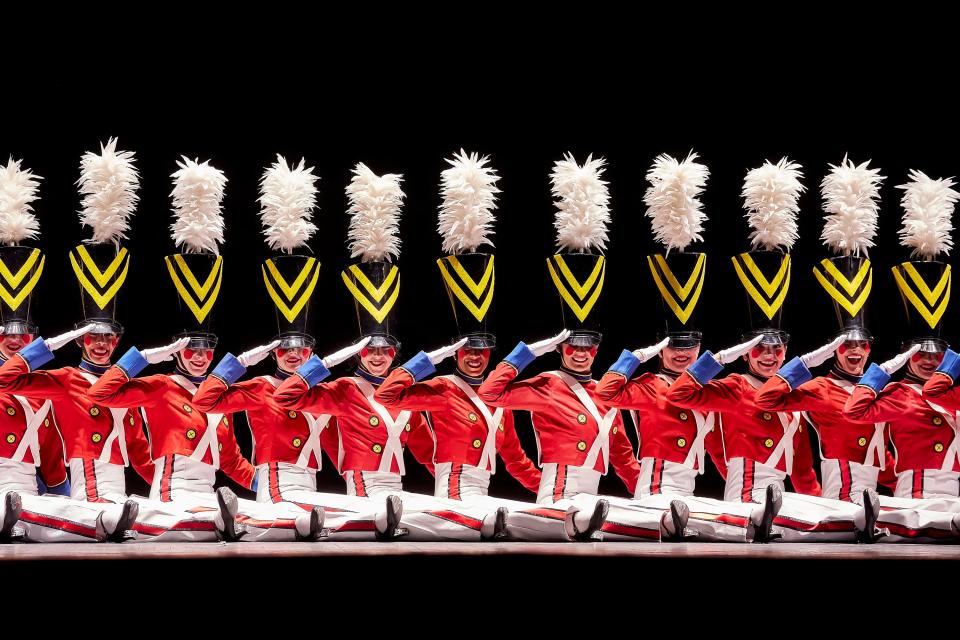
War toys have been around, pretty much, since there has been war — or toys.
Pop guns go back to the 1880s; tin soldiers to the 1730s. What would Christmas be without those parading toy soldiers at Radio City Music Hall?
"I'm sure back before guns, kids had sword fighting," said Ken Hagemann of Tuckerton, who served in the Persian Gulf 1988 to 1989. "It was just part of the ritual of growing into manhood."
The early 1960s was probably the high water mark for this kind of toy. America, then, was still lingering in the afterglow of World War II and Korea. What kid didn't want to be a soldier — just like Pop?
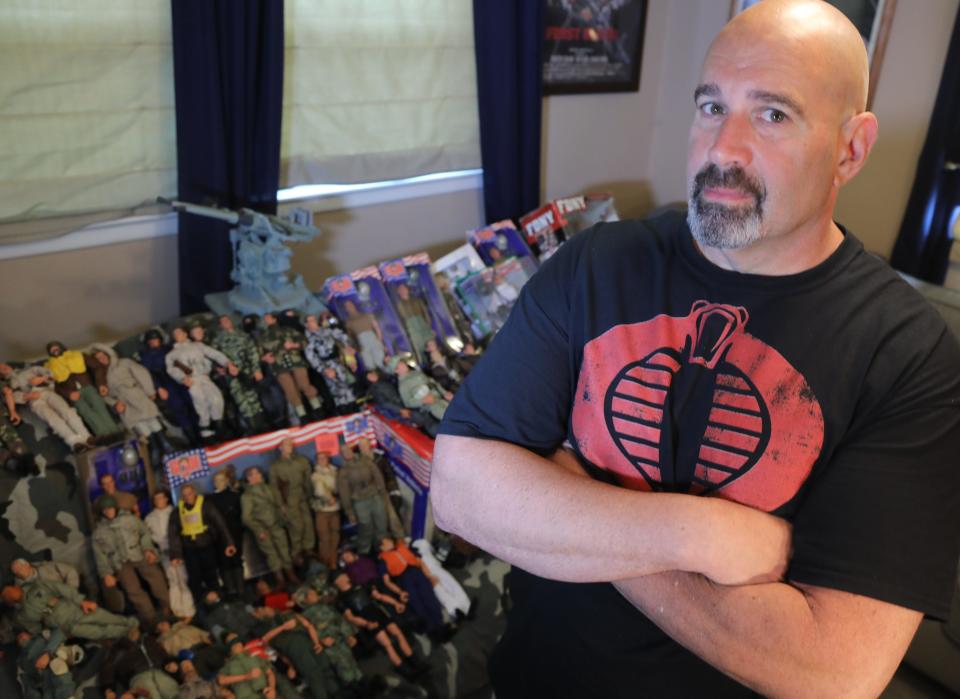
Toy burp guns, M-16s, dog tags, grenades, ammo belts, camouflage helmet complete with netting —"everything for the little company commander to hide under the Christmas tree" — were among the offerings in the 1966 Montgomery Ward holiday catalog. "Combat toys by the truckload," as Jane and Michael Stern said in their study of the decade, "Sixties People."
For many kids, this kind of bloodthirsty play is just a phase — one more step on the road to the office desk, the house, and the pension plan.
But for a certain kind of child, the toy gun and the toy soldier suggests something else. Destiny.
"You want to be a soldier, after watching the G.I. Joe cartoons and playing with the G.I. Joe toys," said Frank Schupp, a Bergen County resident who served as an army medic in Iraq between 1998 and 2014. He now works with several nonprofit veterans programs.
Heroes of the heroes
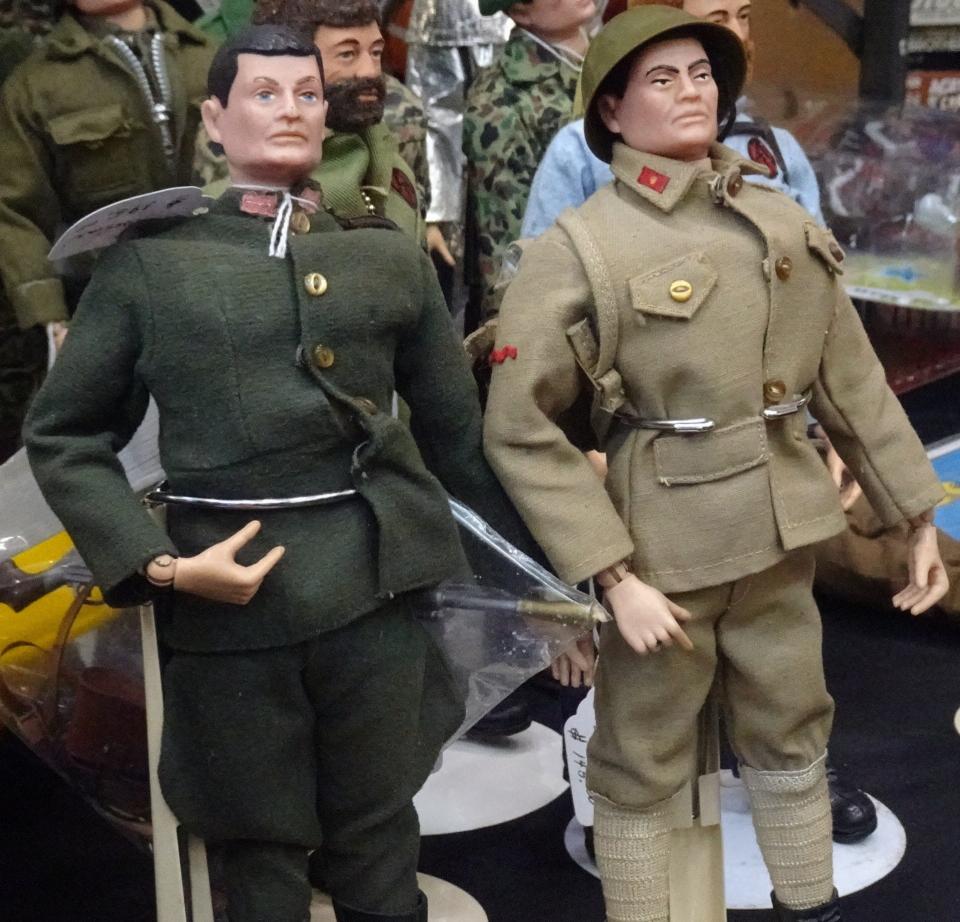
In common with a lot of military people, war toys had a big effect on him. Just how common, he discovered years later in the Middle East, during a lull in operations in 2007.
"I was sitting there with some of my army buddies, and we had some down time, and we literally started talking about which G.I. Joes we preferred, and wanted to be the most like, growing up," he recalled. "Even though we were dealing with all this horrible stuff, this was positive."
His own favorite? Snake Eyes. The Ninja Commando, with his sword and his wolf companion, Timber. "That was cool," he said.
Remember those little green army men? The kind made of plastic, that come to life in the movie "Toy Story"? The ones first made, apparently, in 1938 by the Bergen Toy & Novelty Co. of Carlstadt?
Well Hagemann remembers them too. Only he came from a military family (his father was a Marine). So his were a little different.
"I played in the sand with them, probably when I was five or six years old," he said. "I got some from my uncle Joe. He had blood painted on them."
No G.I. Joes for him. "My father wouldn't let me play with G.I. Joes. He said only girls play with dolls."
And of course, back in the day, nobody thought twice about toy guns.
"I remember being really young, maybe 6 or 8, and I saw a toy gun that when you pulled the trigger, sparks came out," said Boll, an East Hanover resident who grew up in Union. His parents wouldn't buy it for him. For budgetary, not ideological, reasons. It was an uncle who saw how much he wanted it.
"He actually bought that, and brought it to the house and gave it to me as a gift," Boll remembered. "It was as if he was Santa Claus coming to the house."
Fun for a girl or a boy
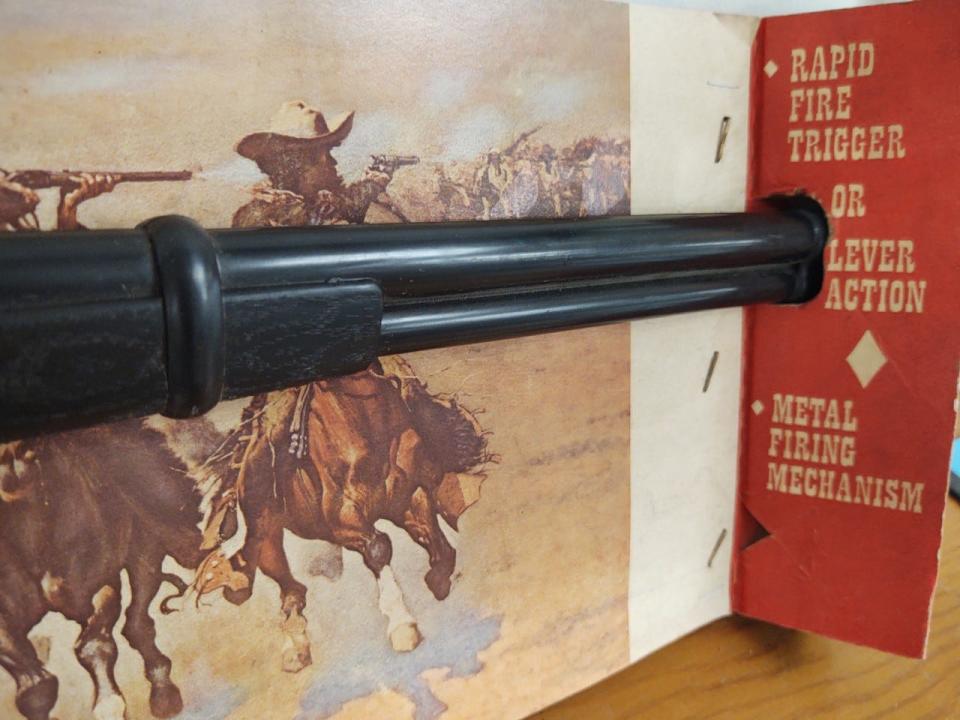
War toys were, of course, primarily marketed to boys. "Remember...every boy wants a Remco toy," was the tag line of their '60s commercials. "And so do girls." they added as an afterthought.
But in real life, gals were also getting in on the mayhem. The changing gender norms in the U.S. military in the 1990s, were actually anticipated in the playgrounds of the 1960s and Seventies.
"We played army, and the girls wore camouflage too," said Barbara Hagemann, wife of Ken, who served in the Persian Gulf. "I camouflaged myself very well. They couldn't find me. It's a myth that we were all in pinafores, rolling strollers."
She, too, came from a military family. And she too, growing up in Kearny, had G.I. Joes. "The G.I. Joes were dating my Barbies," she said. "I always said in the 4th Grade that I would join the military."
Such kids, as they grew, often graduated from war toys to military games of various kinds. Team exercises involving camouflage, hiding behind trees, assailing enemy strong points.
"Me and my best friend, Joe Mayfield, would play every day," Boll said. "We would actually put cork on our faces Friday, and take it off Sunday. I was fascinated with the camouflage, the equipment. We would dig foxholes, make sandbag bunkers."
New recruits
No surprise that, at age 18, he and his BFF signed up together for the Marines.
They were the ones who got the surprise. Once they got to Parris Island S.C., site of the Marine Corps Recruit Depot, they — like many other young recruits — had a rude awakening.
"I remember being in a foxhole, and it rained for two days," he said. "And I just remember everything was soaking wet. At that moment, it wasn't fun playing war anymore. Because you gotta remember, in the Marine Corps, they're constantly yelling at you. And there's all this shooting going on. That was my wake-up call."
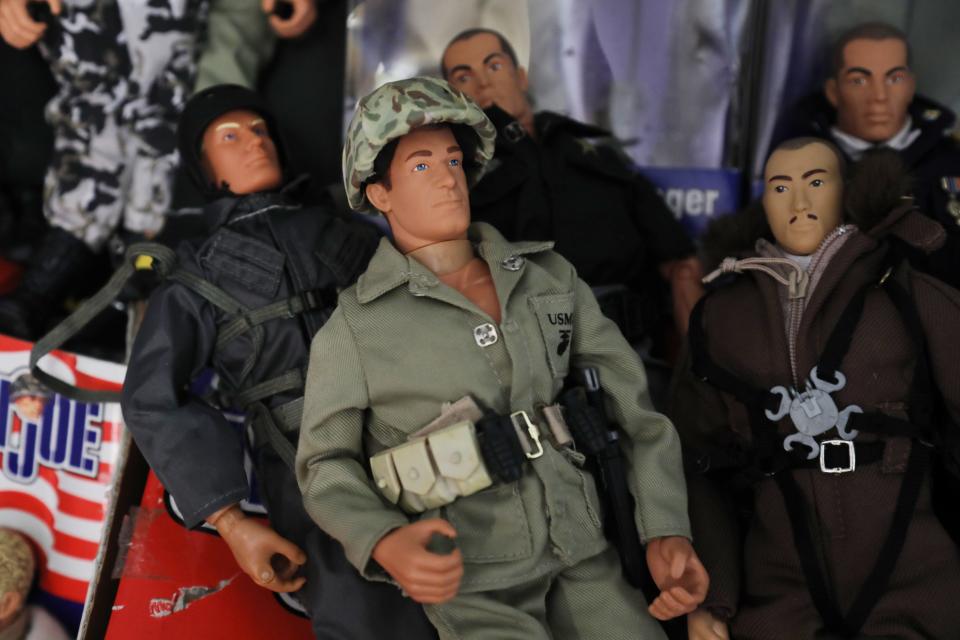
And that, in turn, is nothing compared to the experience of real combat. Surely more than one soldier, facing enemy fire, seeing his buddies suffer and die, must have wondered: did I ever really think this was going to be fun?
"We would joke about this," Boll said. "We'd say, this was not like playing in the woods. Once you go into the military, you're going to rather quickly learn the difference."
Reality check
It was a lesson that, 60 years ago, all of America learned.
In 1964, when G.I. Joe was introduced, there were 216 U.S. casualties in Vietnam. The following year, 1965, when the first African American G.I. Joe was introduced — actually a white doll with his face painted brown — that number had jumped to 1,928. By 1968, when the "talking" G.I. Joe was on everybody's Christmas list, 16,899 people had been killed. "Vietnam was the Scared Straight of wars," Boll said.
Which may explain why, by the late 1960s, attitudes toward such toys began to change.
More and more, parents didn't want their kids being seduced by the exciting, glamorous G.I. Joe version of combat. "People began to question it," Byrne said. "Parents started to think it wasn't heathy for kids to be playing that way."
Down from the store shelves came the toys guns, the grenades, the ammo belts. But getting rid of the toys, as George Orwell pointed out, is not the same thing as getting rid of the craving for them.
"The Socialist who finds his children playing with soldiers is usually upset," wrote Orwell — himself a progressive — in 1940. "But he is never able to think of a substitute for the tin soldiers; tin pacifists somehow won’t do."
Away from reality
In fact, toymakers in the post-Vietnam era did come up with a substitute.
By the time Boll got around to playing with G.I. Joes, in the 1970s and '80s, Hasbro's play soldier had started morphing into a kind of generalized adventure hero. The enemy became abstract: COBRA, not the Viet Cong. War play was given a science-fiction, fantasy sheen. As Byrne puts it: "The shooting went from bang-bang to pew-pew."
The more realistic kind of war-play migrated to video — though violent , first-person-shooter games like "Call of Duty," (rated M for Mature, 17+ by the Entertainment Software Rating Board) are technically meant for adults. Whether their effects are harmful is still being debated.
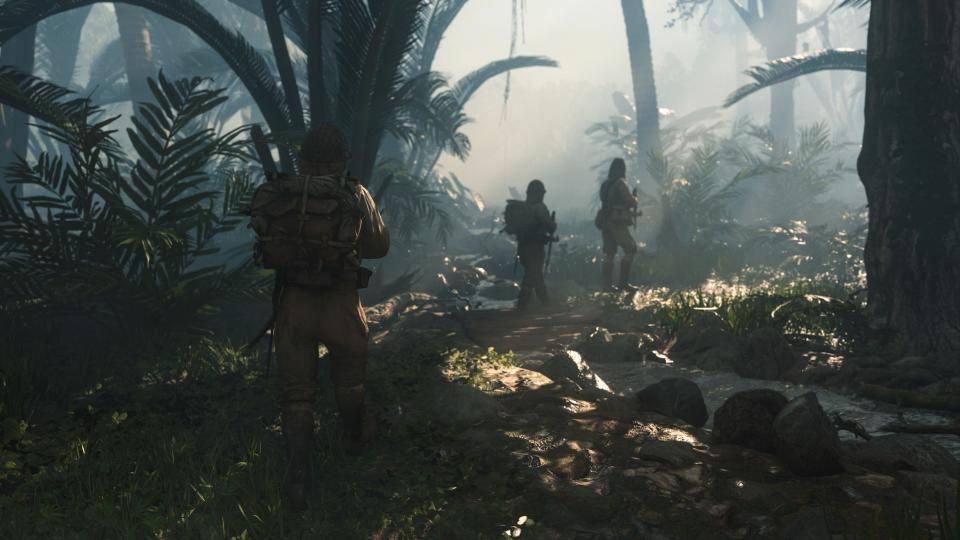
"There is unfortunately no reliable research that shows a correlation between playing violent video games and violent behavior," Byrne said. "Because there's really no way to control for that, to exclude other influences."
Open question
Does war play, in fact, promote war? Does it mislead kids into thinking combat is fun? That question may be no more answerable now, in the age of the Xbox, than it was in the age of the cap gun.
But even Boll — much as he once yearned for an awesome toy gun that shot sparks — isn't really sorry that some kinds of toy weaponry are vanishing from the shelves. He speaks, not only as a Gulf veteran, but also as a former Union police officer.

"I've had a couple of incidents where these guns were used by criminals," he said. "We had a street robbery where they had a toy gun, and nobody knew it was a toy. I remember picking the gun up, and it took 40 or 50 seconds to realize it wasn't a real gun. It was very dangerous."
He still has a soft spot for his G.I. Joes. And he still plays paintball and other war games with like-minded people — both vets and civilians.
But he can always tell the difference between the two.
"The veterans, or anyone who's been involved in training, they're not going to play the same way," he said. "They're more concerned about getting good cover, getting the high ground. They're being more cautious.
"Whereas the children are relying on what they see in the video game. They've never experienced a bullet coming at you."
This article originally appeared on NorthJersey.com: Are war toys a good thing? Or do they promote violence?

